How precision technology can fine-tune beef production
For beef farmer Robert Neill, technology is central to how he manages his system at Upper Nisbet Farm, Jedburgh.
He knows precisely what is going into to his animals and how they are performing, which is allowing him to market his stock at exactly the right time and specification in order to maximise profits.
Mr Neill runs 326 Limousin-cross spring-calving cows on his 640ha beef and arable unit in the Scottish Borders.
See also: Reports, video and photos from the Rethinking Cattle Performance workshops
Animals are mostly sold live through the local auction mart, with a handful sold deadweight to ABP. He has a steady supply of customers, with butchers purchasing one to three of his animals 52 weeks of the year.
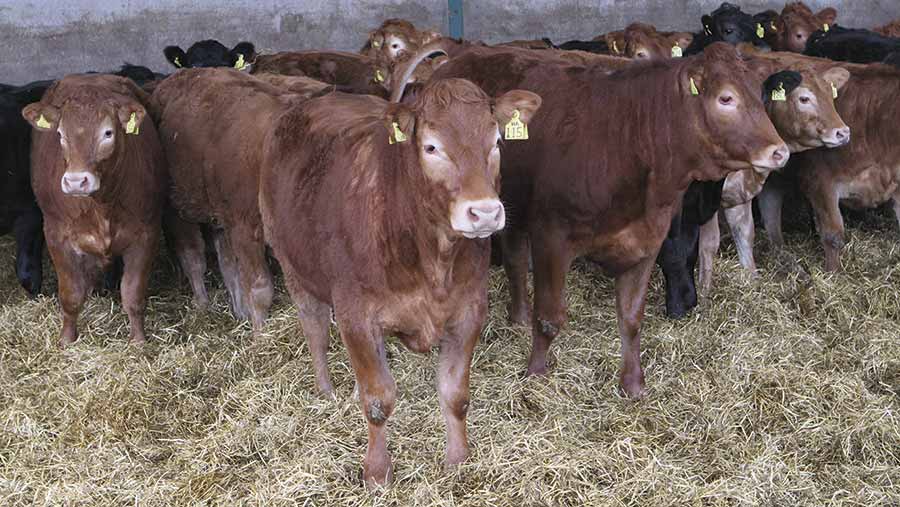
© Billy Pix
He is averaging about 2.20p/kg liveweight for a 600kg carcass and says the secret to getting the most from his stock is producing what the market wants.
Informed decisions
Mr Neill has adopted precision farming to help him make informed decisions and believes this is what all farmers need to be doing.
“In Scotland, only 20% of beef farms have weighing equipment. If you can’t weigh animals, how can you market at the right time?” he asks.
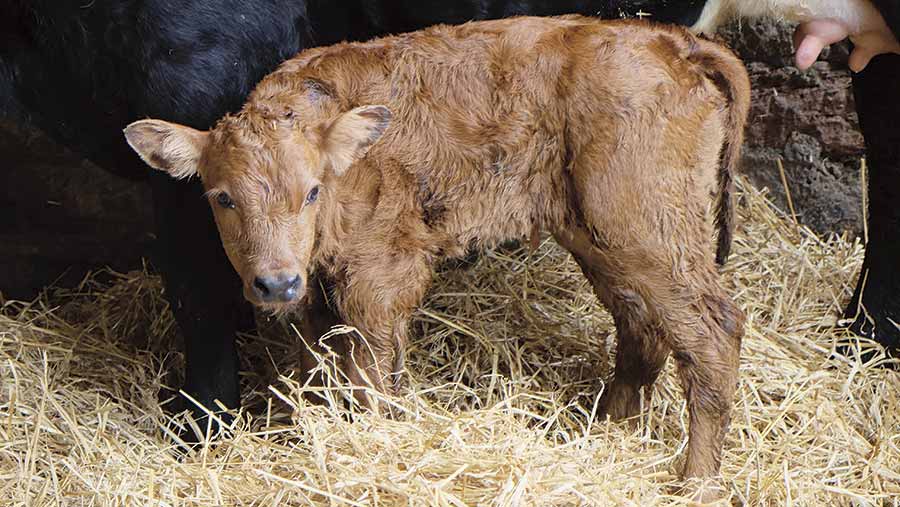
© Billy Pix
Mr Neill says using EID across all his animals and having a good handling and weighing system is central to his beef enterprise.
“The weigh bars and weigh head are the most beneficial thing to my farm,” said Mr Neill at Farmers Weekly’s Rethinking Cattle Performance event, sponsored by Zoetis, ABP/Blade and Volac.
He is weighing finishing animals at least every 30 days to make sure they are not going over 600kg (640kg minus 40kg of gut fill).
Calves are also weighed at weaning when they are about six months old. Any that are not at 200kg at weaning are separated and continued on creep feed.
Automatic weigh crates
Mr Neill also has two automatic weigh crates situated at water drinkers, which measures the weights of his growing and finishing animals every time they go for a drink.
He is also awaiting cameras to be installed above the drinkers to take conformation scores at the same time too.
“Regularly weighing animals allows me to look at diets and make sure they are working, decide when to market animals and to hit spec. This is precision agriculture,” he said.
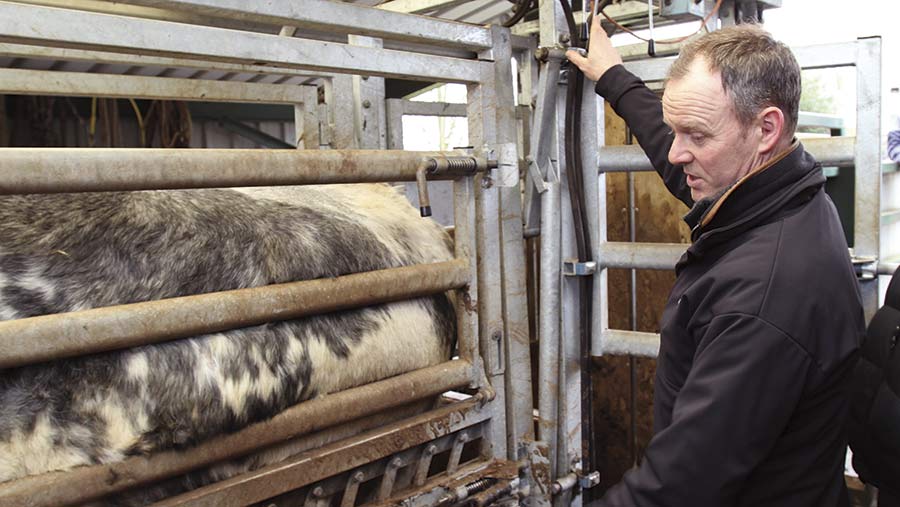
© Billy Pix
Mr Neill can weigh 40 cattle in 10 minutes on his own and can shed cattle three ways. He has software that analyses results, hardware for taking reading and EID tags for identification.
“We use Farmplan Cattle Manager for record-keeping. The animal weights are imported from the weigh system and births and movements automatically notified to BCMS through the programme.”
System set-up
His handling system, which is designed to be safe and minimise animal stress, has a gate that slowly guides the animals through the system. He has installed a squeeze crush rather than a crush with a head yoke to keep animal stress to a minimum.
“I don’t want to go to the head of the animal to read the eartag, as it upsets them.
“The EID reader attached to the system means I don’t have to.”
He also has air-operated gates, making it easy to get stock in and out of the crate. It is also quieter.
Costs
he whole system set him back £10,000-£15,000 for the crush and hydraulics, which were imported from South Island in New Zealand, and £3,500 for the weigh bars and weigh head.
“If you are going to handle stock, you need a good weigh system. If you handle an animal badly, it has a knock-on effect on growth rate.
“There is never going to be more labour on farms, so you need to think of that when designing a handling system,” he said.
When stock is run through the handling system, the EID reader situated on the crush picks up their tag and will give a daily liveweight gain. It will also tell you specific animal details such as their date of birth, past issues, medicine records and whether an animal can be sold (taking into account meat withdrawal periods from past treatments).
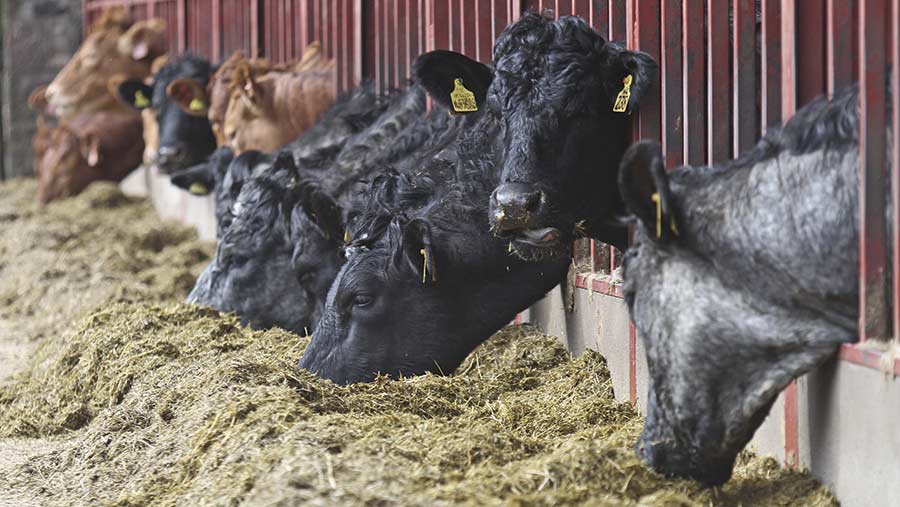
© Billy Pix
His system is also linked up to a labelling machine that can print individual animal identifications. This has proved particularly handy when taking blood samples from cows, said Mr Neill.
“This has speeded up the process and reduces human error,” he said.
Mr Neill said before going to market he weighs and clips the back, belly and tails of his cattle so they look their best.
“It takes five minutes to do. It’s all about marketing and selling and we need to present what we sell in a better fashion, “ he said.
Body condition score recorder
Mr Neill is also trialling a body condition score stick reader for TRuTest and believes being able to record condition scores at the penside straight to the reader will make fine-tuning easier.
“We condition score cows about three times over the winter period and adjust feeding accordingly. The stick reader will make this easier to do, as you can scan the animal’s tag and record the condition score on the stick reader at the same time.”
Identification of animals
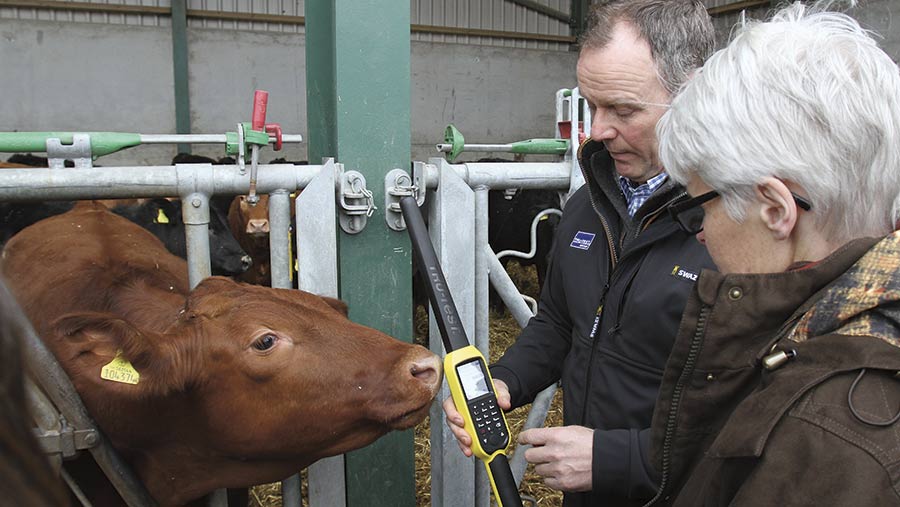
© Billy Pix
However, precision farming doesn’t mean splashing out lots of money on bits of kit. Basic routines, such as using management tags and recording the sire initials on the tags, help Mr Neill make decisions about breeding in the future.
“We use colour-coded management tags to make the job easier. For example, red disks highlight heifer calves we don’t want to keep as replacements and blue disks are used for males that haven’t been castrated.”
Feeding
Mr Neill is using an Alltech Keenan feeder wagon with PACE system attached. This tells him exactly what needs to go into the diet and how long it needs to be mixed for, so he knows exactly what stock is being fed. He can then fine-tune the diet by keeping a close eye on the performance of his animals.
Richard Vecqueray from Evidence Based Veterinary Consultancy, who was speaking at the event, said farmers have a number of levers they can pull to determine the performance of beef cattle to help match the farm’s genetics with the market being targeted.
He said to be able to correctly pull these levers, farmers need to know:
- Current performance in terms of body condition and daily liveweight gain, because this provides a baseline from which to improve.
- The exact analysis of the input feeds, the most variable being the forage.
“Only by measuring animals and knowing exactly what is being fed, can you fine-tune the system.”
Mr Vecqueray added that more silage analysis was needed in order to define input loads better.
“Using computer formulation with substandard information [a one-off NiR silage analysis] is an expensive waste of time. The likely result of such an exercise is you being sold something completely inappropriate, adding unnecessary cost in an industry with no margin to spare,” he said.
“If you are only doing one or two silage analyses a year using NiR, which analyses silage by looking at the level of reflected light, it is not likely to be representative of the silage you are feeding.
“If you really want to fine-tune and push growth rates at a younger age then you may want to invest in more forage analysis or the gold standard, which is wet chemistry analysis. Wet chemistry is more expensive, but more accurate,” he said.
Targets for finishing rations
Target growth rates for finishing animals
- Large-framed animal (on ration for 80-100 days): 1.5kg/day
- Medium-framed animal (on ration for 60-80days): 1.4kg/day
- Small-framed animal (on ration for 0-60 days): 1.3kg/day
Target intakes and rations for finishing animal
- Dry matter intake (DMI): 2% of body weight
- Dry matter: 30-60%
- Crude protein: 12-15% (higher values form British breeds, lower values for continentals)
- Energy: 12.2 MJ/kg DM ME (depends on breed and desired growth rate)
- Fat: <6%
- Starch and sugars: 33%
- Calcium: 0.6%
- Long fibre: 6-8% (introduce gradually over seven to 10 days on to full finishing ration)
Information from AHDB Beef and Lamb
Attend an event
The last Rethinking Cattle Performance Event is taking place on Thursday 31 March. To find out more about the event and register your interest to attend visit Rethinking Cattle Performance
Thanks to ABP, Zoetis and Volac, whose sponsorship made it possible to run this Rethinking Cattle Performance workshop. Farmers Weekly had full editorial control of this article.
Sponsors’ message
“ABP, Volac and Zoetis are committed to supporting UK cattle farmers in running enterprises that produce healthier, more productive animals.
Part of this commitment means working with organisations such as Farmers Weekly on initiatives such as the ‘Rethinking Cattle Performance’ campaign, to offer farmers the opportunity to learn from experts and their peers about the best ways to produce cattle, and particularly calves, as efficiently as possible.
